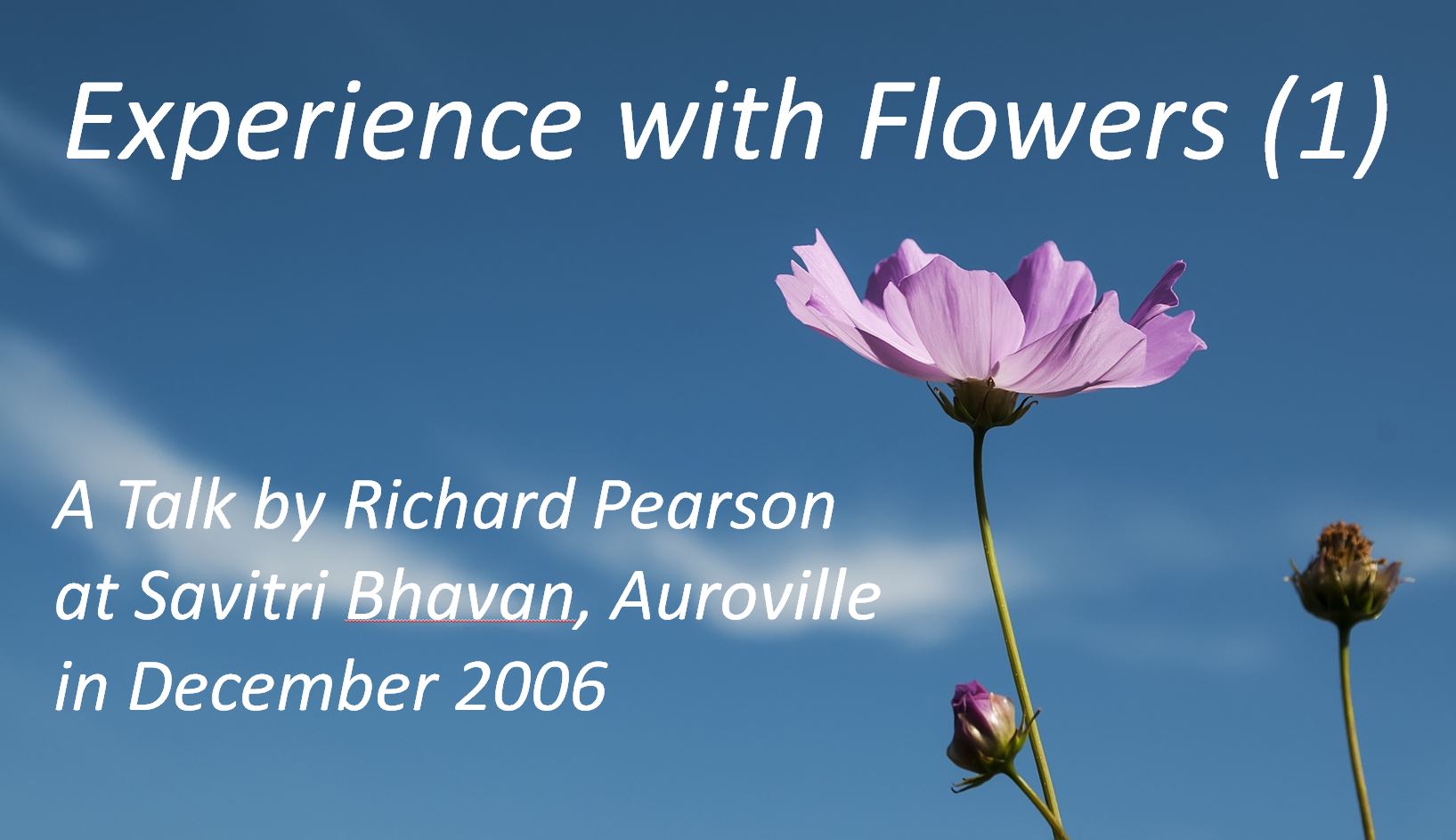This is an audio recording of the first of two talks on flowers, which were delivered at Savitri Bhavan in December 2006 and January 2007. For the second talk a fragment of the video recording will also be posted.
About Richard Pearson: Richard was born in the north of England on 1 November 1934, in a Yorkshire town called Shepley. He was just eleven years old when he first came to the Sri Aurobindo Ashram with his father in 1946. He started to live in the ashram from then and studied in the ashram school. For his higher studies, he did not leave the ashram upon Mother’s words but studied Botany in the ashram library. Later he served as a teacher in the Ashram school and as captain in the Physical education department. Today, he lives in the ashram and continues to offer his life in service to the Mother.
Flowers and Their Messages
(from “Interview with Richard Pearson, Teacher, botanist, captain, and editor of Flowers and Their Messages” by Anie Nunnally)
Anie: When did the flower work begin and the work on the book Flowers and Their Messages?
Richard: I was always touched by the array of flowers arranged in trays when we went one by one to see the Mother. Mother would give us a flower and look deeply into our eyes, so very deep. I would take the flower straight home and keep it in a bottle or vase and keep it fresh for as long as possible. (“Answering with the flower’s answer to the Sun, they gave themselves to Her and asked no more.”—Savitri)
When I saw the book Le Role de Fleurs by Lizelle Raymond, a French woman living in the Ashram, published in 1953, I found the introduction to be a masterpiece. It was about how flowers were offered to the Mother and how she gave her blessings through flowers. “There are three ways of blessing of the Mother: by sight, by touch, and through flowers. And it is through flowers that her blessing is most effective,” Sri Aurobindo is reported to have written.
I was very touched by the book. All the flowers were in order according to the French names given. When I saw it, I found some mistakes in the botanical names and in the significances. I wrote to the Mother asking if I could work on a flower book that would contain all the names Mother had given. Mother said, “Yes, this could be done.”
This development began the new classification in 1957, but it was not completed until 1973. During the work, Pavitra sent messages to the Mother for me. He was another of my mentors. When I went to his room, as soon as I entered I would feel that I was in the Mother’s room, so strong was her force. In his presence, I would feel the presence of the Mother. [Pavitra, a Frenchman, whose European name was P.B. Saint-Hilaire, was a highly skilled scientist and engineer. He was head of the Ashram school and secretary to the Mother. Pavitra’s name, given by Sri Aurobindo, means “the pure.”]
When Auroville was inaugurated and the idea for the twelve gardens was being worked out with Roger [Anger], Mother called me to bring as many hibiscus flowers as possible to Auroville. I went every Tuesday. At the first meeting with Mother, she explained that she wanted to choose a hibiscus flower for each of the gardens. The first day, she chose “Supramental Consciousness” for the Garden of Consciousness. “It is so luminous,” she remarked.
Richard Eggenberger (named Narad by the Mother) helped me in bringing the flowers. The work on the flowers began with great vigor in the first gardens of Auroville when Narad started the nursery for Matrimandir Gardens in 1969. He collected many varieties and beautifully built up the gardens.
Hibiscus flowers would come from the nursery for the Mother and would be left at the Ashram reception. Kailas and I would go and, if possible, paint these flowers before they went upstairs. Mother first called “Godhead” the Auroville flower, but then changed it to “Beauty of Supramental Love.” She told me that this flower was similar to the rich, red color of Auroville soil. Many hibiscus were given names for Auroville: “The Success of Auroville,” “The Firmness of Auroville,” “The Concentration of Auroville,” etc. Later, she changed the word Auroville to “New Creation.”
The biggest gift from the Mother for the work with flowers was the commentaries she gave on the flowers. She would work on about five flowers per day at a fixed time. These were checked the following day by Tara. These commentaries, done in 1970 and 1971, were for the “flower book,” which was still in progress. When they were translated by Tehmi into English, Narad came in the evenings, all the way from Auroville, to help with the botanical and common names, and descriptions of the flowers and the plants for Flowers and Their Messages.
Since Mother used flowers as a help for our spiritual progress, Kailas felt that the relevant quotations from the writings of the Mother and Sri Aurobindo would help the reader. So she chose appropriate passages. Lyn Miller did the line drawings.
At later stages, I would go to the press to check certain details in the hand-set final proofs. The book was one of the early publications from Auropress.




